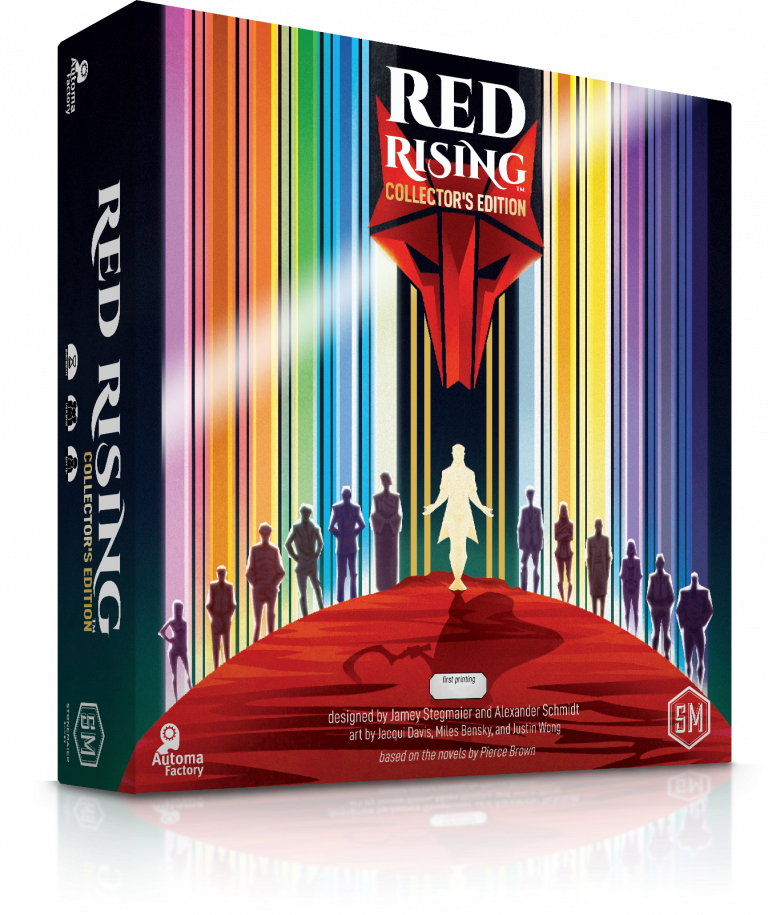Table of Contents
Red Rising is based on the book series by Pierce Brown. I have never read and if I am honest, when I first played Red Rising I still had no interest in reading the novels. The theme is the very thing that put me off Red Rising when I was first offered it for review.
It’s not that I had declined to review Red Rising previously, more that I had other games I felt I would enjoy more. Last month Stonermaier offered me Red Rising for review again and here we are.
If you have read my reviews you know I am generally quite upbeat and can see the positives of most titles, however, and as I have said before if I don’t like something I will tell you about it as my commitment is to the truth and to you.
The Components
Red Rising is published by Stonemaier so it should go without saying the quality of the components is second to none.
I was sent the Red Rising Deluxe Edition which included metal Influence Cubes, metal fleet tokens, a metal Sovereign Token and a metal Crescent Moon which is the first player token and 21 of the 112 character cards have gold foil on them. There are also cardholders so you don’t have to strain your fingers.
There was also a very cool tray in the shape of a wolf head which holds the red gems which represent helium in the game.
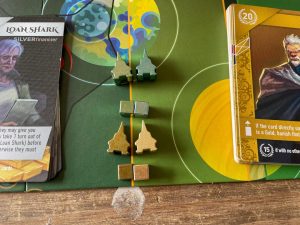
From a sensory perspective, the visuals are striking with bright and vivid colours, couple that with the texture of the cards and the weight of the individual influence cubes and my inner magpie, he who must covet shiny things wants to love Red Rising.
My first negative is going to come here and I think it will be the first time I have ever said anything negative about a Stonemaier component. The four of the colours used for the different players’ components are so similar that I genuinely couldn’t tell some apart. These are blue/green and bronze/gold.
I am accused of being colour blind quite often, I am not, I am just stupid but my son and daughter were honest enough to say they were similar, however, my wife who disagrees with everything I say by default thought she could tell them apart.
We played that night in the living room with just the lamps on, she did not realise I had switched two of her cubes with mine. She is reading this just after it has been posted I suspect and finding out what I did. I know you are thinking “I didn’t” Nicole, I know you are also smiling now I told you what you are thinking, but I did, check the box, they are still mixed up!
Red Rising Story
So, my house just became a warzone and I am living in a dystopian present, Red Rising, on the other hand, is set in a dystopian future where the colour of your house matters for some reason.
Perhaps there is a hidden meaning about race or tribal affiliation but if it’s explained in-game it’s far too subtle for the bludgeon that is my brain to understand. Maybe if I read the Red Rising books I would understand but I haven’t, many gamers will not have so this explanation of the story is for you.
Each card in Red Rising is from one of 14 colours. In the Red Rising universe, the colours denote the level of your social status. Gold is at the very top and there are 21 gold cards in the game. Each other colour has 7 cards and the lowest echelon of the societal hierarchy is Red. These guys are the labourers and I would imagine they clean the sewers and are treated poorly.
Like I said I haven’t read any of the books but I would be surprised if someone from the Red class has not risen and brought down the carefully crafted society by uniting the colours.
Don’t get me wrong, I love sci-fi but, I love almost realistic, Sci-Fi. Specifically Hard Sci-fi, that is to say, Sci-Fi that is based on a plausible reality. Think Star Trek Warp Drive over Back to the Future Flux Capacitor and you will see where I am in terms of relative reality.
So I have not thought about reading the Red Rising books and I am not coming at this with an understanding of the story of Red Rising. This is OK, it means I have to judge Red Rising on its own merits, I have to judge it for what it is, a board game.
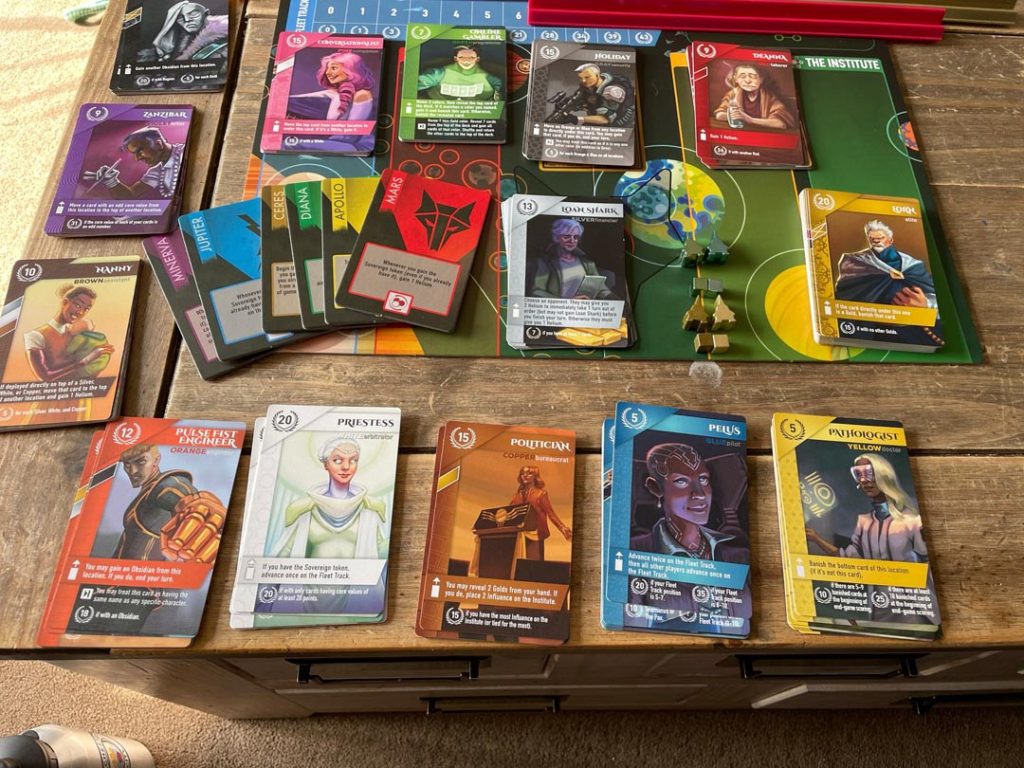
An opportunity missed?
I started to dislike Red Rising as soon as I read the manual because of my biased prejudice about what I thought the game was. The actual game is essentially a hand management game where you score because of the combos you have created with your hand. No, I thought the game was going to be different and so my opinion was based on the game it could have been based on the components I had already seen in the box.
Like most people, I open a box and spend a good deal of time going through the components before sitting down with a cup of tea and reading the rule book.

When I looked at the cards, I wrongly surmised the type of game I might soon be playing, the orange cards said engineer, the obsidian cards said assassin, yellow doctor which got me quite excited, that was short-lived however as it means nothing. Nothing, the roles have no impact on what the card can do whatsoever. Why, dag-nam-it? Perhaps I have missed something but why have roles defined if the role is only mildly related to some scoring system?
Blue Pilot Pelius, scores 20 if your fleet track position is 5-7 but 35 if your fleet track position is 8-10. OK, she is a pilot which could be a good bonus if you keep her, however, if you deploy her instead, you can advance twice on the fleet track and all other players advance once. Oh, nice it’s going to be about making a choice between keeping a card and using its ability to increase your score in a specific area of the game. I like the idea of set collection but with the danger of losing your card, Red Rising you saucy flirt.
So Blue are pilots and moving the fleet track is what pilots do. Great, that’s very Piloty isn’t it? Good so Blue are the only cards that can advance you on the fleet track, that makes sense and means that you have to use blue for this but what about the other colours, what do they do?
Priestess, this is a White Arbitrator card, what does she do when deployed. Well if you have the Sovereign token you advance one on the fleet track.
OR
If you played Janitor, a Brown Assistant card on top of a Green, Yellow or Blue you can put that card to the top of another location and advance one on the fleet track.
Why? There is an opportunity to add choices, balances, payoffs and strategy to Red Rising and this area is being missed completely, or so I thought. I have written hundreds of reviews in my time, I like to think I can separate my feelings and view things analytically but when I sat and read the rules I was really disappointed to discover, what I felt was, an obvious omission to gameplay and this assumption definitely jaded my opinion of Red Rising once we started.
The Game
The cards in Red Rising come in 14 different colours, they are
- Red: Labourers
- Brown: Janitors
- Violet: Artists
- Pink: Companions
- Orange: Engineers
- Yellow: Doctors
- White: Arbitrators
- Blue: Pilots
- Green: Programmers
- Obsidian: Assassins
- Grey: Security
- Copper: Bureaucrats
- Silver: Financiers
- Gold: Elites
There are also 6 houses these are
- Mars: Red
- Apollo: Yellow
- Diana: Green
- Ceres: Gold
- Jupiter: Blue
- Minerva: Purple
Red Rising is playable by 1 to 6 players and the single-player Tull Au Toma rules are in a separate manual. As with other Stonemaier games, the automa is fairly robust and can offer a way to play alone however, I have only played this way once as it doesn’t feel right playing against random chance. To really come alive, this game needs an opponent or five.
Set up
Set up is fast, from opening the box to taking your first turn takes less than two minutes for two players to get everything ready. Much of this is thanks to the excellent insert which helps organise components between games.
After you place the board you shuffle then place the deck on its location and put two cards from it onto each location on the board, they are Jupiter, Mars, Luna and the Institute. These cards are placed face up and only the last card placed on these stacks should be fully visible leaving only the names, colours and point values of the cards beneath visible.
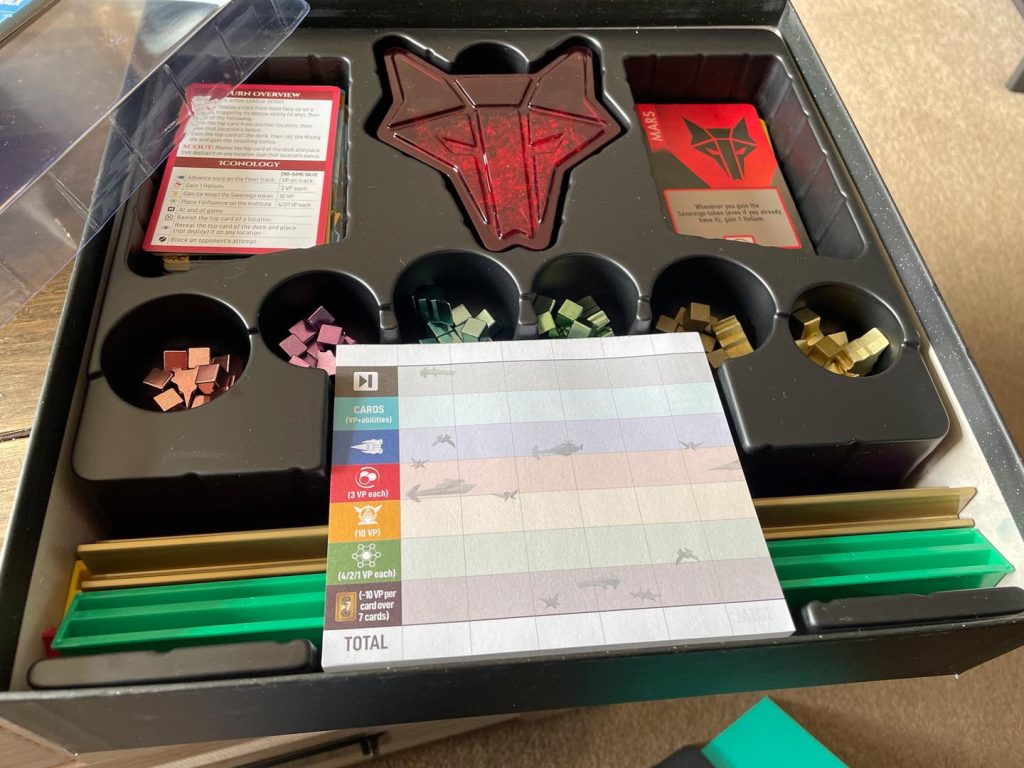
Deal 5 cards to each player which will be their starting hand and randomly draw a house tile for each player, everyone then takes their matching tokens, these are 10 influence cubes and a rocket-shaped counter which you place on the fleet track. If there are only two of you take three cubes from an unused house and put those cubes into the Institute to make scoring at the end of the game more competitive.
Place the deck and Wolf head tray onto their locations on the board and place the sovereign token nearby.
The first player marker goes to House Apollo if they are in play or randomly assign it if not using whichever method you wish.
Hand out the quick reference cards and you can begin playing Red Rising.
Game Mechanics
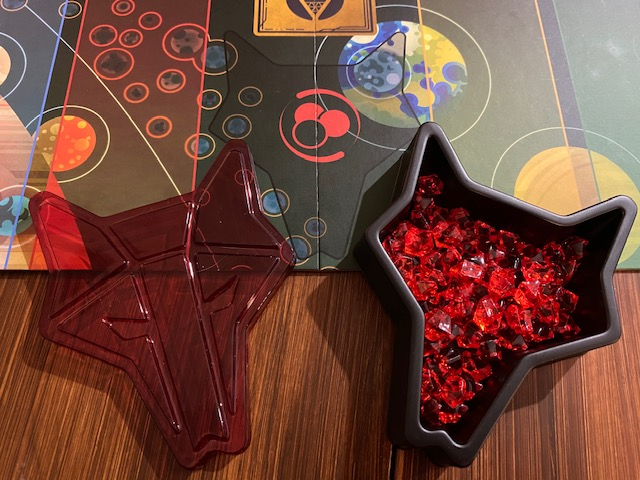
During your turn you can take one of two actions, you may either Lead or Scout.
If you Lead you “Deploy” a card from your hand to the board by placing it on top of the face-up card in a location of your choosing. If there is a deploy action on the card you just played you would perform this action now.
Next, you can choose the top card from a location except for the one you played a card to. For example, if you deployed to Luna, then you can take the top card from either Jupiter, Mars or The Institute, you would then gain that location’s bonus.
Or you could choose to “Place” the top card from the deck, known as to “Scout”. If you choose to Scout then after drawing you place the card on a location, you do not get the location’s bonus and instead roll the dice and gain the bonus from the dice.
The dice bonuses are all positive for the dice roller, you could banish the top card from a location, giving you potential access to the card below, you could take the top card from the deck and place it on a location, gain the sovereign token, gain helium, move one on the fleet track or place an influence cube at the institute. This is why you should be paying attention to your opponents because you do want to block them from gaining an advantage, don’t you?
The difference between placing and deploying cards is that when you deploy a card you get its deployment bonus and the bonus from the location, when placing the card the only bonus you receive is the one from the dice.
It’s as simple as that, keep taking turns until one of you has met two end of game requirements or three of the end game requirement conditions have been met by different players.
Gameplay
Deploying cards from your hand in order to draft new cards or gather resources is always a considered decision. You might not get the card you played back, I would say in 3 and 4 player games you will very rarely if ever, get your card back. The decision to deploy a card is also a decision to lose that card.
What if another player takes that card, what if you are making an error and isn’t it lucky that Red Rising isn’t more complicated by the colours of the cards and what the individual character can do?!
Yes, my first impressions about the need for a more strategic implementation was completely wrong. There are so many variables to consider in every turn that you make if individual abilities or rules were added to each card played then the game would become unmanageable.
As it stands formulating a strategy and playing well took me at least three games before I felt even mildly comfortable.
The early game, for me, is about gaining influence and moving along the fleet track, gaining helium and trying to work out what the other players are doing. The late game is all about increasing the number of cards in my hand. Getting together complementary cards and making sure I have cards that score with each other, checking the bonuses and doing a lot of calculations based on what I have and what I see.
Red Rising gives me a brain burn and after playing I feel a little punch drunk. I am sure the more I play the easier this will become but even now, after more than 13 games, I still don’t feel confident in the way I play.
The cards you play are all unique, every single one is named with its own artwork. Each card has a different value, different conditions for bonuses, end game activations or deployment benefits.
I am not a mathematician but I suspect there is probably not an infinite combination of combinations however, in the practical sense, there is no way you will ever see the same scoring combo more than once in your time with Red Rising.
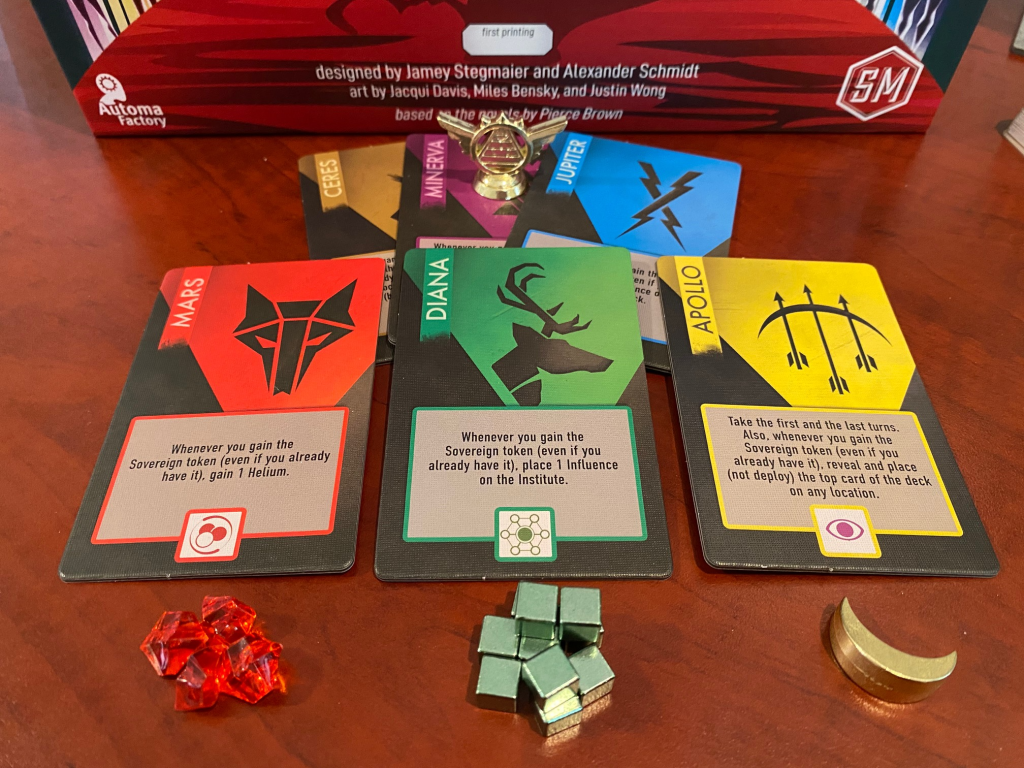
There are lots of heart-pounding moments where you are watching a location because there is a card you want and you have to wait and watch in agonising hope that the card is not covered or taken before it is your turn to snag it, while this is happening you are trying to calculate possibilities.
The intensity of each turn and the number of moving parts you are trying to keep track of making it difficult, not impossible, just difficult to track what an opponent is doing. During a three or four-player game I have not been able to keep track of other players but I do feel as my comfort level grows, I will be able to take stock of likely moves more than 1 opponent will be making and trying to block them or stall their plans while working on my own.
There is also a risk-reward aspect to each turn at play too. When your hand is taking shape for your final scoring you will often be faced with the option to deploy a card you want to keep to obtain another card that will benefit you. Will you get the card you playback and if you don’t what could you do?
What is the likely hood of you losing that card vs the benefit of gaining a new card? These self-doubting moments are what make 2 player games so intense and the inability to trust yourself to have worked things out correctly during 3 and 4 player games make each turn agonisingly difficult. 2 player games are currently my sweet spot for a strategic game and 5 player games may as well be solo games as there is so little interaction with other players. I just look at the board during my turn and take an action based on what I see now.
Planning ahead is practically impossible during the 5 player game and I have yet to play with 6, however, I imagine that this would be similar to the 5 player experience.
Having a plan that has to change on the turn before yours is frustrating and delightful in equal measure and with that, the 2 player experience is just enough frustration and just enough delight to keep me interested currently.
Red Rising starts as a game that feels too simple but the pressure quickly ramps and you are suddenly aware that you have analysis paralysis and have been contemplating in silence for a minute. The downtime between turns is not realised however as you are also contemplating your next move just without the pressure of having to act.
A typical decision in Red Rising is based on the point value at the top left vs the ability that a card would have for deployment that may gain you something positive vs the bonuses which you may lose if you play the card vs what you would gain if you keep it vs what cards are available on the board vs the bonuses on other cards that you could lose if you deploy the card et cetera. You can see the number of factors in a simple decision about whether to play the card or not and you may have several cards in your hand that you are making these same decisions for.
When you have factored the complicated decisions in it’s easy to see why tracking other players is not a simple matter.
Not only that but some cards will allow you to return cards that are further down the stack. The number of decisions and options during every turn is staggering.
This is before your opponent starts banishing the cards you want, maybe they are doing a better job of tracking you and your consternation is just giving them more time to study you? Damn my brain hurts just thinking about the games I have played.
Red Rising has a bewildering array of options to consider when making a move then but, as the game draws on and an opponent becomes happy with their hand they begin to take more and more scout actions, they are looking to gain their final points towards the end game goals you suddenly realise.
“Bastard, I am not ready”
When you notice this the panic sets in and a scrabble begins as you try to gain points as fast as you can. Checking what combinations of cards you have and looking to improve your hand when you are clearly behind is exciting and the urgency somehow lets me think more clearly.
I tend to think “aaargh no, not now”
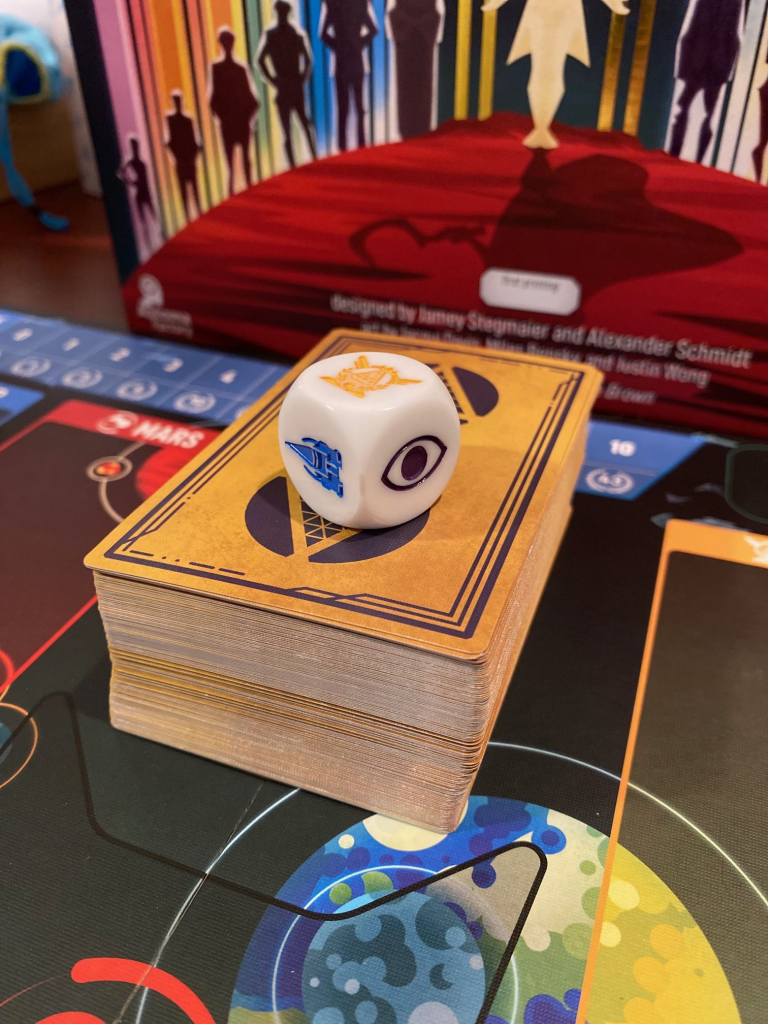
The negatives explained.
In truth, there is not much to dislike about Red Rising, it’s a surprisingly simple game that is so complicated you might just faint. This is not a hard game to teach, yet the first games with a new player will have you facing someone who has no idea what is going on, they will be taking random cards and have no idea what the end of the game is going to be like.
It takes a good few matches with the same people before there is any semblance of competition and I lost people who decided they didn’t like Red Rising and were not that interested in playing a second game, despite my promises that it will be better, because they really didn’t gel with the concept and they refused to understand the game was not greatly impacted by their understanding of the universe and more by the sheer complexity of the decisions they had to make.
The colour of the cubes in the Deluxe set should be changed but I have seen the standard set advertised and it appears to have none of these issues, see the images above for this one.
Getting into Red Rising is going to be difficult for people not familiar with or not interested in the subject matter which could be a big hurdle to finding people to play with as on the surface it does appear to be important.
Rarely, you can end up having your starting hand decimated by players banishing your cards or stealing them so a little house rule to stop this was required because taking out a better player is very tempting when you have only played a couple of games and have a few cards capable of this between a few new players.
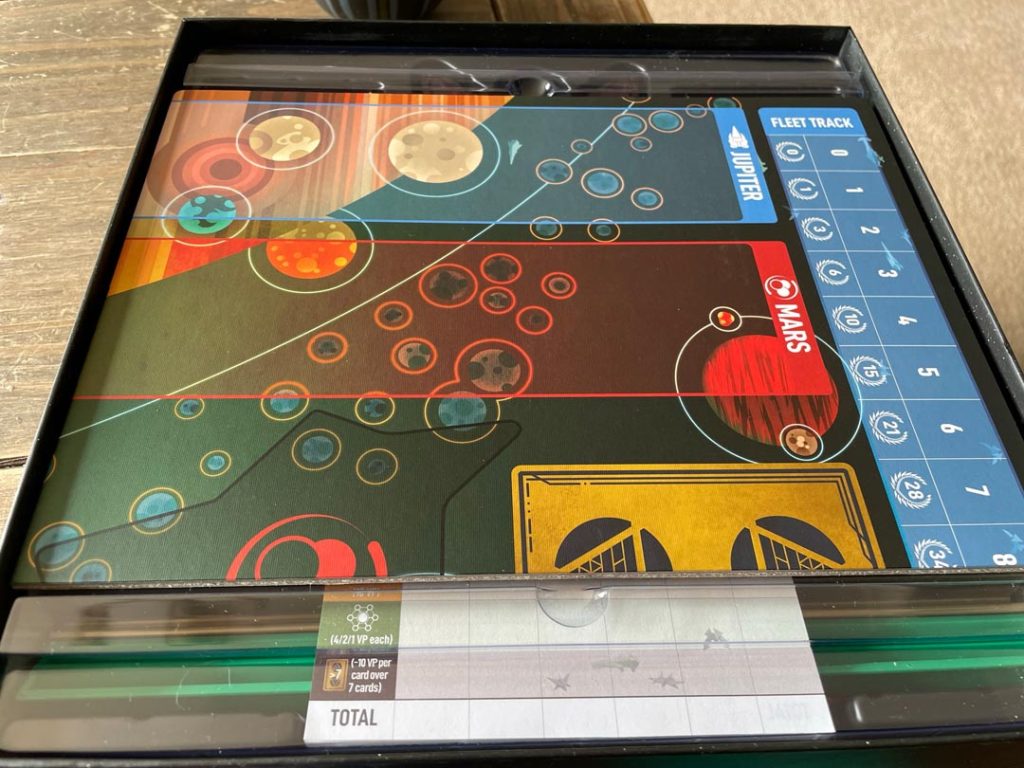
In Summary
There is so much more to Red Rising than I can cover here because I would be trying to explain the nuances of every single match I have played.
The more games I play the more I learn and the variety of options and choices made during the games make trying to capture that experience in text incredibly challenging.
I am going to finish by telling you that Red Rising is a very good game. It will not be for everyone, point of fact, if I had not been reviewing it I would probably have given up when I didn’t understand what the game was.
I am so glad I was forced to persevere past my initial ignorance as I have had a great deal of fun. The bewildering array of potentials during every game means that Red Rising is infinitely replayable and whilst I think the sweet spot is the 2 player game there is an awful lot of joy to be experienced at higher player counts.
Perhaps I will be reading the Red Rising books after all.
| Prices delivered by BoardGamePrices | |
|---|---|
 | Red Rising £21.48 with shipping, in stock! Buy now See all 49 offers! |

